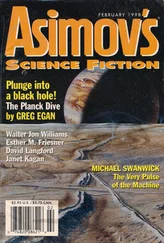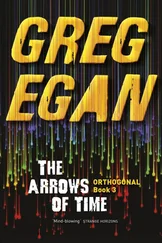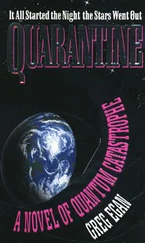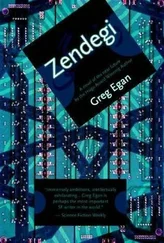Rakesh absorbed the model's results. Parantham's conclusions were hard to dispute.
"So this place was starved from the beginning?" he said. "When they missed the neutron star, they had no hope?" The children of the Arkmakers, designed to escape the fate of their planet-bound parents, had found themselves stranded with the wrong biology, trapped inside an ingenious machine for extracting energy from an exotic new source that was receding into the distance at a few hundred kilometers a second.
Parantham said, "No hope for themselves. But I can't believe this was the only ark. There could have been a dozen, there could have been a thousand. If they really saw no prospect of fleeing from the neutron star, every resource on the planet would have been used to maximize the chances of hitching a ride."
Rakesh looked around at the ruins of this desperate strategy, and tried to picture the same tunnels teeming with life while the hot wind from a neutron star's accretion disk whistled through the walls. Perhaps the extraordinary gamble could have paid off, if they'd repeated it a sufficient number of times.
"If they hitched a ride, where did it take them?" Rakesh asked. When he and Parantham had first realized what it was that had created the asteroid belt, they had run dynamical models and checked the maps, but they'd been unable to locate the neutron star that had done the deed. The only thing that had been clear was the general direction of its motion.
"Toward the center," Parantham replied. "Deeper into the core."
As the work team gathered in the Calculation Chamber, Roi caught sight of Neth and proclaimed hopefully, "Sixth time brings success!"
"Sixth?" Neth replied. "Surely this is the third?"
"It's one task to frame a hypothesis, then another to test it," Roi insisted. "So that's six separate acts."
Neth was too polite to object, and perhaps too serious to understand that Roi was only joking. If the proverb was worth anything, it certainly wasn't worth taking literally. It did encourage persistence, though, and Roi had a feeling that their persistence was finally going to be rewarded.
Since Neth's discovery that orbits around the Hub might become unstable, a dozen or so members of Zak's original team had left to educate hatchlings into the secrets of weight and motion, and a dozen more had headed for the sardside, with the even more ambitious aim of recruiting a new team to build Bard's tunnel. The task of those who remained was to find a geometry for space and time that satisfied Zak's principle, in the hope of learning more about the dangers the Splinter would face in the future.
Tan had refined his ideas for characterizing geometry to the point where he could calculate the natural paths — the closest things to straight lines — on any curved surface. The vital step that remained, though, was to find the correct way to move from the geometry of space alone to a version that included time.
When Tan analyzed a path on a curved surface, he broke it up into a multitude of tiny, straight line segments of equal length. These small straight lines acted as markers for the direction of the curve. The geometry of the surface could then be embodied in a simple mathematical rule that Tan called a "connection". The connection allowed you to take a direction at one point and shift it to another, nearby point, in a manner that respected the geometry of the surface. If a curve was a natural path, then when you broke it up into line segments and used the connection to shift them all one step forward, the shifted segments would coincide with the originals: shifting the first segment one step along the curve would give you the original direction of the second segment, and so on. If the curve was not a natural path, then the directions would fail to agree, and the resulting discrepancies would be a measure of how much the curve swerved unnecessarily, as opposed to merely following the geometry.
That the curves were broken into line segments of equal length was a crucial part of the recipe, because the analysis had to yield the same verdict if the surface was picked up and rotated, or if two people were viewing it from different angles. If you decreed that the curve should be broken up some other way, such as into segments that spanned equal horizontal distances, then different people would be left arguing over which direction was "horizontal". Nobody would argue as to whether two successive segments were of equal length. With the connection respecting this rule — preserving the lengths of the segments as it moved them from point to point — everything worked smoothly, and everyone agreed on which paths constituted natural motion and which did not.
What happened, though, when you considered the path of a tossed stone, moving forward in time as well as through space? Anyone could draw a picture in which some chosen direction represented time, and the path of a moving object slanted across the skin, but how could people ever agree on the correct scale for such a diagram? Whether one heartbeat, one shift, or one lifetime passed from the top of the skin to the bottom was a completely arbitrary choice.
Nevertheless, suppose you settled on a scale. What would happen if you divided the path of a stone into segments of equal length? To Roi, who tossed a stone forward across the Null Chamber at one span per heartbeat, the path she drew would slant across the skin. If Zak happened already to be moving at the same pace in the same direction, the stone would be motionless to him, so he would draw a line that stretched solely in the time direction. Suppose that after five heartbeats, the stone hit an obstacle. Zak's line would be "five heartbeats" long, whatever the scale of the picture made that. Roi's line, though, would have to be longer: it would stretch five heartbeats in the time direction, but it would also cross five spans of space. The accounts of the two experimenters had to be compatible somehow, but they couldn't expect to draw their separate diagrams and then measure the same path lengths.
What could they agree on? The simplest answer anyone in the team had been able to suggest was the time that had elapsed. If you marked off segments of the stone's path representing equal intervals of elapsed time , everyone would agree how many segments there were from start to finish. If you looked for a connection that respected this scheme by never changing the amount of time spanned by a segment, then everything would have a chance to work smoothly.
This was what the team had tried first. They had hunted for a geometry of space and time whose connection left intervals of time unchanged, and which obeyed Zak's principle.
In less than one shift, they had found one. In this geometry, everything was symmetrical about a special point, where the Hub could sit. The natural paths of the geometry included circular orbits around the Hub. The square of the period of each such orbit was proportional to the cube of its size. And the ratio between the garm-sard weight and the shomal-junub weight was precisely three. Close to the Hub, far from the Hub, always, everywhere, three.
It was the answer that Zak had guessed long ago, when he'd thought the Map of Weights might still hold true. It possessed an elegant simplicity, but it was impossible to reconcile with the measurements they had made. The current ratio of weights was two and a quarter; that had been confirmed a dozen times.
This failure had cast some doubt on the idea that natural motion could be described by the same kind of geometrical principles that applied to space alone. The team had considered looking for a completely new direction, but the consensus had been that they shouldn't give up on Tan's ideas so easily.
Was there any other rule that the connection could obey that might make sense? Could the idea of "constant length" that worked so well in space alone somehow be applied in the new context, in spite of the obvious problems?
Читать дальше











